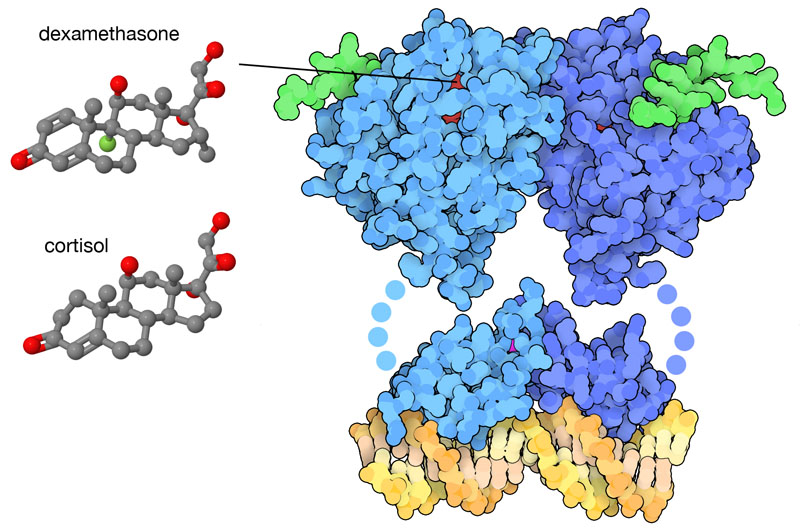Dexamethasone and Cytokine Storms
Preventing too much of a good thing during SARS-CoV-2 infection

Infection by SARS-CoV-2 is not life-threatening for most people, but in too many cases, the virus has deadly consequences. In some of these individuals, the virus is thought to induce an over-active inflammatory response, referred to as a “cytokine storm” (cytokines are molecules that regulate the immune system). An uncontrolled inflammatory response to SARS-CoV-2 infection damages cells in the lungs and throughout the body, greatly increasing the severity of COVID-19 disease and the likelihood of death. Short-term treatment with the anti-inflammatory drug dexamethasone is currently being used to fight this progression and has been shown to provide better outcomes for patients with advanced forms of the disease.
Dexamethasone in Action
Dexamethasone is an anti-inflammatory steroid drug that closely mimics steroids normally made by our adrenal glands, such as the body’s main stress hormone cortisol. Natural steroids like cortisol circulate through the blood and regulate many physiologic and cellular functions, including the immune system. Nearly every cell in our body has receptors for these steroids: the glucocorticoid receptor. The receptor is normally sequestered in the cytoplasm by chaperone proteins, but when it binds to endogenous steroids that have entered the cell by crossing the plasma membrane (or exogenous steroids such as dexamethasone), it is transported through the nuclear pore into the nucleus where it dimerizes, binds to promoter DNA, and regulates expression of about 5% of our estimated 20,000 or so protein-encoding genes.
Dissecting the Receptor
The glucocorticoid receptor protein consists of several globular domains (linked by unstructured segments of the polypeptide chain) with different functions: a DNA-binding domain (shown here from PDB ID 1r4r) and a ligand-binding domain (shown here with bound dexamethasone from PDB ID 1m2z). In addition to connecting everything together the unstructured segments interact with the cell’s transcriptional machinery. Several additional proteins like the TIF2 coactivator play supporting regulatory roles (see small piece of TIF2 shown above in green). Structures of the glucocorticoid receptor have been essential for understanding its diverse effects on gene regulation and for discovering new anti-inflammatory agents to fight diseases such as asthma and rheumatoid arthritis, and now, COVID-19.
Double-edged Sword
Like all approved drugs, dexamethasone can induce adverse events (or side effects) in patients. Use of dexamethasone (and other corticosteroid drugs that act by binding to and activating the glucocorticoid receptor) causes increased appetite, irritability, insomnia, fluid retention, heartburn, impaired wound healing, and hyperglycemia in more than 30% of patients. Less commonly, dexamethasone usage is associated with headaches, dizziness, mood swings, and cataracts and bone thinning (with long-term use). Severe psychiatric adverse events are seen in nearly 6% of patients, including euphoria, hypomania, and frank psychosis. These symptoms frequently present early in a course of treatment and typically resolve with dose reduction or discontinuation.
More Information
- Lin, S.H., Zhao, Y.S., Zhou, D.X, Zhou, F.C., Xu, F. (2020) Coronavirus disease 2019 (COVID-19): cytokine storms, hyper-inflammatory phenotypes, and acute respiratory distress syndrome. Genes Disease, in press. https://doi.org/10.1016/j.gendis.2020.06.009
- Timmermans, S., Souffriau, J., Libert, C. (2019) A general introduction to glucocorticoid biology. Front. Immunol. 10, 1545.
- Weikum, E.R., Knuesel, M.T., Ortlund, E.A., Yamamoto, K.R. (2017) Glucocorticoid receptor control of transcription: precision and plasticity via allostery. Nat. Rev. Mol. Cell Biol. 18, 159-174.
- T.P. Warrington, J.M. Bostwick (2006) Psychiatric Adverse Effects of Corticosteroids. Mayo Clin. Proc. 81, 1361-1367.
- R.M. Stanbury, E.M. Graham (1998) Systemic corticosteroid therapy-side effects and their management. Br. J. Ophthalmol. 82, 704-708.
Entries from the PDB Archive Discussed in this Article
- 1m2z: Bledsoe, R.B., Montana, V.G., Stanley, T.B., Delves, C.J., Apolito, C.J., Mckee, D.D., Consler, T.G., Parks, D.J., Stewart, E.L., Willson, T.M., Lambert, M.H., Moore, J.T., Pearce, K.H., Xu, H.E. (2002) Crystal structure of the glucocorticoid receptor ligand binding domain reveals a novel mode of receptor dimerization and coactivator recognition. Cell 110, 93-105.
- 1r4r: Luisi, B.F., Xu, W.X., Otwinowski, Z., Freedman, L.P., Yamamoto, K.R., Sigler, P.B. (1991) Crystallographic analysis of the interaction of the glucocorticoid receptor with DNA. Nature 352, 497-505.



